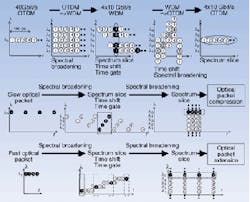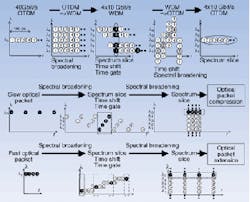Gateway connects at high rates
Incorporating news from O plus E magazine, Tokyo
TOKYOIn combination with Osaka University, scientists at the Communications Research Laboratory of the Ministry of Posts and Telecommunications have created an optoelectronic gateway that connects optical networks while maintaining optical signals. They have developed a connection that can mutually convert between a 40-Gbit/s optical time-division multiplexed (OTDM) and a 40- wavelength-division multiplexed (WDM) signal, as well as compress and decompress 40-Gbit/s and 10-Gbit/s optical packets (see figure).
For conversion between a 40-Gbit/s WDM and a 40-Gbit/s OTDM signal, the spectral width of a 4 x 10 Gbit/s OTDM signal is broadened using supercontinuum technology (top). An array waveguide diffraction grating is then used to shift the time axis of the pulse per wavelength. Using a supersaturated absorption gate module, the signal is extracted at the time axis that includes points 1 to 4. In this way, a 40-Gbit/s OTDM can be converted to a WDM. When converting from WDM to OTDM, all of the wavelengths are time-shifted, the spectral width is broadened, and the wavelength that includes points 1 to 4 is extracted and converted to OTDM.
Conversion between two 10- and 40-Gbit/s OTDMsthat is, the compression and decompression of optical packetscan also be accomplished (center and bottom). To convert from 10 to 40 Gbit/s, the spectral width of the 10-Gbit/s signal is broadened and the time-axis of the pulse shifted per wavelength. Then, the signals at the time-axis with points 1 to 4 are extracted. Finally, the spectrum is expanded and one wavelength is extracted. To convert from 40 to 10 Gbit/s, the spectrum is expanded and the signals are extracted per wavelength. The time axis is then shifted so that points 1 to 4 all match the 10-Gbit pulse. The signals 1 to 4 are extracted at 10 Gbit/s; finally, the spectrum is expanded to a single wavelength.
Transmission speeds and multiplexing formats differ depending on the network. Currently, these various optical networks are connected by first converting the optical signals to electrical signals. The conversion process prevents the entire network from reaching the highest possible transmission speed. The newly developed mutual conversion capability allows 40-Gbit/s optical signals to be freely processed.
For these operations, optical-signal- processing techniques in the spectral domain and the time domain are crucial. In the spectral domain, spectrum expansion techniques (using supercontinuum light emission) and multiplex spectrum slicing techniques (using array waveguide diffraction gratings) are valuable. In the time domain, the critical components are time shifting (using delay lines) and the picosecond time gate (using supersaturated absorption gate modules). Supercontinuum technologies that were originally developed for WDM light sources can broaden spectral width while maintaining optical intensity. Supersaturated absorption gate modulesoptical switches that can be controlled using lighthave a semiconductor waveguide structure that resembles that of semiconductor lasers.
Future plans include further conversion between different multiplexing devices, including optical code-division multiplexers. In addition to developing backbones for large-scale networks, the growth of basic optical networks for home use is also anticipated.
Courtesy O plus E magazine, Tokyo

